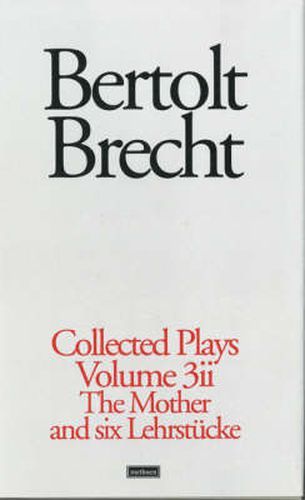Readings Newsletter
Become a Readings Member to make your shopping experience even easier.
Sign in or sign up for free!
You’re not far away from qualifying for FREE standard shipping within Australia
You’ve qualified for FREE standard shipping within Australia
The cart is loading…






One of the greatest poets and dramatists of our century (Observer)
Brecht’s Lehrstucke or short ‘didactic’ pieces written during the years 1929 to 1933, are some of his most experimental work. Rejecting conventional theatre, they are spare and highly formalised, drawing on traditional Japanese and Chinese theatre. They show Brecht in collaboration with the composers Hindemith, Weill and Eisler, influenced by the new techniques of montage in the visual arts and seeking new means of expression. Brecht intended them for performance by schools, workers’ groups and choral societies rather than by professionals, with the idea that the moral and political lessons contained in them are best conveyed by participating in an actual production.
In addition to the Lehrstucke, the volume contains The Mother, a longer play, again with music by Eisler, based on the novel by Gorky. A story of dawning political consciousness, told with irony and narrative drive, its central character is one of Brecht’s great female roles. The original production starred Brecht’s wife Helene Weigel and Brecht was buried with the red flag that was a prop in the production.
$9.00 standard shipping within Australia
FREE standard shipping within Australia for orders over $100.00
Express & International shipping calculated at checkout
One of the greatest poets and dramatists of our century (Observer)
Brecht’s Lehrstucke or short ‘didactic’ pieces written during the years 1929 to 1933, are some of his most experimental work. Rejecting conventional theatre, they are spare and highly formalised, drawing on traditional Japanese and Chinese theatre. They show Brecht in collaboration with the composers Hindemith, Weill and Eisler, influenced by the new techniques of montage in the visual arts and seeking new means of expression. Brecht intended them for performance by schools, workers’ groups and choral societies rather than by professionals, with the idea that the moral and political lessons contained in them are best conveyed by participating in an actual production.
In addition to the Lehrstucke, the volume contains The Mother, a longer play, again with music by Eisler, based on the novel by Gorky. A story of dawning political consciousness, told with irony and narrative drive, its central character is one of Brecht’s great female roles. The original production starred Brecht’s wife Helene Weigel and Brecht was buried with the red flag that was a prop in the production.